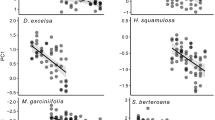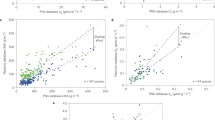Abstract
Because leaf size scales negatively and isometrically with leaf number per shoot size (leafing intensity) in woody species, and because most tree and shrub species have small leaves, Kleiman and Aarssen (J Ecol 95:376–382, 2007) recently proposed that natural selection favors high leafing intensity resulting in small leaves, i.e., the leafing-intensity-premium hypothesis. However, empirical evidence for or against this hypothesis is still lacking. In addition, this hypothesis has not been examined in the context of how leaf size varies among habitats. To fill this void, we investigated leaf size frequency distributions of woody species from temperate China and explored the relationships among leaf mass, leaf number, and stem mass of current-year shoots of 133 woody species at low and high altitudes of three mountain ranges. The scaling relationships between leaf size and leafing intensity (leaf number per stem mass) were determined using both standardized major axis regression analyses and phylogenetically independent comparative techniques. In light of the leafing-intensity-premium hypothesis, we made three predictions: (1) leaf size frequency distributions should be right-skewed for each local study area and for the entire study region, (2) leafing intensities at different altitudes at different sites should differ while leafing intensities at comparable altitudes should be similar baring large taxonomic differences among sites, and (3) that leafing intensity should be higher for any given leaf size in habitats with small-leaved species. Significant negative and isometric scaling relationships between leaf size and leafing intensity were found to be consistently conserved independent of habitat type, both across species and across correlated evolutionary divergences. Within each mountain range or across the entire study region, leaf size frequency distributions were right-skewed, in accordance with our prediction. However, leafing intensity was smaller for any given leaf size at the altitude with smaller leafed species than for altitudes characterized by large leafed species, i.e., altitudes characterized by species with small leaves did not have consistently higher leafing intensities than other altitudes on each mountain range. Our analyses therefore indicate the direct adaptive value of leaf size but not the selective advantage in high leafing intensity as posited by the leafing-intensity-premium hypothesis. We suggest that this hypothesis explains less about the variation of leaf size among different habitats as it does about variation within habitats, i.e., the relative importance of the adaptive significance of leafing intensity and leaf size can and does vary with habitats.


Similar content being viewed by others
References
Aarssen LW (2005) Why don’t bigger plants have proportionately bigger seeds? Oikos 111:199–207
Ackerly DD, Donoghue MJ (1998) Leaf size, sapling allometry, and Corners rules—phylogeny and correlated evolution in Maples (Acer). Am Nat 152:767–791
Ackerly DD, Reich PB (1999) Convergence and correlations among leaf size and function in seed plants, a comparative test using independent contrasts. Am J Bot 86:72–81
Bonser SP, Aarssen LW (1996) Meristem allocation, a new classification theory for adaptive strategies in herbaceous plants. Oikos 77:347–352
Brouat C, Gibernau M, Amsellem L, McKey D (1998) Corner’s rules revisited, ontogenetic and interspecific patterns in leaf-stem allometry. New Phytol 139:459–470
Chapin FS (1980) The mineral nutrition of wild plants. Annu Rev Ecol Syst 11:233–260
Cornelissen JHC (1999) A triangular relationship between leaf size and seed size among woody species, allometry, ontogeny, ecology and taxonomy. Oecologia 118:248–255
Corner EJH (1949) The durian theory or the origin of the modern tree. Ann Bot 13:367–414
Cunningham SA, Summerhayes BA, Westoby M (1999) Evolutionary divergences in leaf structure and chemistry, comparing rainfall and soil nutrient gradients. Ecol Monogr 69:569–588
Falster DS, Warton DI, Wright IJ (2006) User’s guide to SMATR: standardised major axis tests and routines version 2.0, Copyright 2006. http://www.bio.mq.edu.au/ecology/SMATR/. Accessed 13 Nov 2006
Givnish TJ (1978) Ecological aspects of plant morphology, leaf form in relation to environment. In: Sattler R (ed) Theoretical plant morphology. Leiden University Press, Leiden
Givnish TJ (1979) On the adaptive significance of leaf form. In: Solbrig OT, Jain S, Johnson GB, Raven PH (eds) Topics in plant population biology. Columbia University Press, New York
Givnish TJ (1984) Leaf and canopy adaptations in tropical forests. In: Medina E, Mooney HA, Vázquez-Yánes C (eds) Physiological ecology of plants of the wet tropics. Dr. W. Junk Publishers, Boston, pp 51–84
Givnish TJ (1987) Comparative studies of leaf form, assessing the relative roles of selective pressures and phylogenetic constraints. New Phytol 106:131–160
Givnish TJ, Vermeij GJ (1976) Sizes and shapes of liane leaves. Am Nat 110:743–778
Halloy SRP, Mark AF (1996) Comparative leaf morphology spectra of plant communities in New Zealand, the Andes and the European Alps. J R Soc NZ 26:41–78
Karban R, Myers JH (1989) Induced plant responses to herbivory. Annu Rev Ecol Syst 20:331–348
Kleiman D, Aarssen LW (2007) The leaf size/number trade-off in trees. J Ecol 95:376–382
Körner C (1989) The nutritional status of plants from high altitudes. A worldwide comparison. Oecologia 81:379–391
Lehtilä K, Tuomi J, Sulkinoja M (1994) Bud demography of the mountain birch Betula-pubescens ssp. tortuosa near tree line. Ecology 75:945–955
Li GY, Yang DM, Sun SC (2008) Allometric relationships between lamina area, lamina mass and petiole mass of 93 temperate woody species vary with leaf habit, leaf form and altitude. Funct Ecol 22:557–564
Maillette L (1982) Structural dynamics of silver birch: 1. The fates of buds. J Appl Ecol 19:203–218
Marquis RJ (1984) Leaf herbivores decrease fitness of a tropical plant. Science 226:537–539
Martins EP (2004) COMPARE, version 4.6b. Computer programs for the statistical analysis of comparative data. http://compare.bio.indiana.edu/, USA
McDonald PG, Fonseca CR, Overton JM, Westoby M (2003) Leaf-size divergence along rainfall and soil-nutrient gradients: is the method of size reduction common among clades? Funct Ecol 17:50–57
Milla R, Reich PB (2007) The scaling of leaf area and mass: the cost of light interception increases with leaf size. P R Soc B 274:2109–2114
Niinemets Ü, Kullm O (1999) Biomass investment in leaf lamina versus lamina support in relation to growth irradiance and leaf size in temperate deciduous trees. Tree Physiol 19:349–358
Niinemets Ü, Portsmuth A, Tobias M (2006) Leaf size modifies support biomass distribution among stems, petioles and mid-ribs in temperate plants. New Phytol 171:91–104
Niinemets Ü, Portsmuth A, Tena D, Tobias M, Matesanz S, Valladares F (2007a) Do we underestimate the importance of leaf size in plant economics? Disproportional scaling of support costs within the spectrum of leaf physiognomy. Ann Bot 100:283–303
Niinemets Ü, Portsmuth A, Tobias M (2007b) Leaf shape and venation pattern alter the support investments within leaf lamina in temperate species, a neglected source of leaf physiological differentiation? Funct Ecol 21:28–40
Niklas KJ (1999) A mechanical perspective on foliage leaf form and function. New Phytol 143:19–31
Niklas KJ, Cobb ED, Niinemets Ü, Reich PB, Sellin A, Shipley B, Wright IJ (2007) “Diminishing returns” in the scaling of functional leaf traits across and within species groups. Proc Natl Acad Sci USA 104:8891–8896
Orians GH, Solbrig OT (1977) A cost-income model of leaves and roots with special reference to arid and semiarid areas. Am Nat 111:677–690
Parkhurst DF, Loucks OL (1972) Optimal leaf size in relation to environment. J Ecol 60:505–537
Pitman EJG (1939) A note on normal correlation. Biometrika 31:9–12
QPSIG (Qinghai–Tibetan Plateau Science Investigation Group of Chinese Acaademy of Sciences) (1992) Dry valley of Hengduan mountain zone (in Chinese). Scientific Press, Beijing
Rossiter MC, Schultz JC, Baldwin LT (1988) Relationships among defoliation, red oak phenolics, and gypsy moth growth and reproduction. Ecology 69:267–277
Schuepp PH (1993) Tansley review 59, Leaf boundary layers. New Phytol 125:477–507
Sun SC, Jin DM, Shi PL (2006) The leaf size—twig size spectrum of temperate woody species along an altitudinal gradient: an invariant allometric scaling relationship. Ann Bot 97:97–107
Tang CQ, Ohsawa M (1999) Altitudinal distribution of evergreen broad-leaved trees and their leaf-size pattern on a humid subtropical mountain, Mt. Emei, Sichuan, China. Plant Ecol 145:221–233
Taylor SE (1975) Optimal leaf form. In: Gates DM, Schmerl RB (eds) Perspectives in biophysical ecology. Springer, New York, pp 73–86
van Noordwijk AJ, de Jong G (1986) Acquisition and allocation of resources: their influence on variation in life history tactics. Am Nat 128:137–142
Vogel S (1970) Convective cooling at low airspeeds and the shapes of broad leaves. J Exp Bot 21:91–101
Warton DI, Weber NC (2002) Common slope tests for bivariate errors in-variables models. Biom J 44:161–174
Warton DI, Wright IJ, Falster DS, Westoby M (2006) Bivariate line-fitting methods for allometry. Biol Rev 81:259–291
Webb CO, Ackerly DD, Kembel SW (2008) Phylocom: software for the analysis of phylogenetic community structure and trait evolution. Bioinformatics 24:2098–2100
Westoby M, Wright IJ (2003) The leaf size–twig size spectrum and its relationship to other important spectra of variation among species. Oecologia 135:621–628
Wolfe A (1995) Paleoclimatic estimates from tertiary leaf assemblages. Annu Rev Earth Planet Sci 23:119–142
Wright IJ, Westoby M (2002) Leaves at low versus high rainfall, coordination of structure, lifespan and physiology. New Phytol 155:403–416
Wright IJ, Westoby M, Reich PB (2002) Convergence towards higher leaf mass per area in dry and nutrient-poor habitats consequences for leaf life span. J Ecol 90:534–543
Wright IJ, Reich PB, Westoby M, Ackerly DD, Baruch Z, Bongers F, Cavender-Bares J, Chapin FS, Cornelissen JHC, Diemer M, Flexas J, Garnier E, Groom PK, Gulias J, Hikosaka K, Lamont BB, Lee T, Lee W, Lusk C, Midgley JJ, Navas M-L, Niinemets Ü, Oleksyn J, Osada N, Poorter H, Poot P, Prior L, Pyankov VI, Roumet C, Thomas SC, Tjoelker MG, Veneklaas EJ, Villar R (2004) The world-wide leaf economics spectrum. Nature 428:821–827
Xiang S, Wu N, Sun SC (2009) Within-twig biomass allocation in subtropical evergreen broad-leaved species along an altitudinal gradient: allometric scaling analysis. Trees Struc Funct 23:637–647
Yang DM, Li GY, Sun SC (2008) The generality of leaf size versus number trade-off in temperate woody species. Ann Bot 102:623–629
Acknowledgments
We thank Professors Mark van Kleunen and Karl J. Niklas for their insightful comments and English improvement, and Xianming Gao, Guoyong Li, Xinwei Wu, Dongmei Yang, Dongmei, Jin, Yan Li, Yanan Li, Yin Zhou, Shuo Wang and Qin Shi, Gang Pang for field assistance. We also thank the staff of Maoxian Ecological Station of Chinese Ecosystem Research Network and biological stations at Mount. Emei and Mt. Changbai for permitting this study to be conducted. This study was funded by NSFC (30670333), the Chinese Academy of Sciences (KZCX2-XB2-02), and Special Research Program for Public-welfare Forestry (200804001).
Author information
Authors and Affiliations
Corresponding author
Appendix
Appendix
See Table 5.
Rights and permissions
About this article
Cite this article
Xiang, S., Wu, N. & Sun, S. Testing the generality of the ‘leafing intensity premium’ hypothesis in temperate broad-leaved forests: a survey of variation in leaf size within and between habitats. Evol Ecol 24, 685–701 (2010). https://doi.org/10.1007/s10682-009-9325-1
Received:
Accepted:
Published:
Issue Date:
DOI: https://doi.org/10.1007/s10682-009-9325-1




